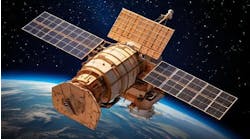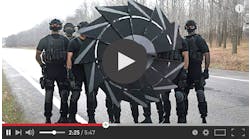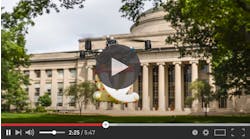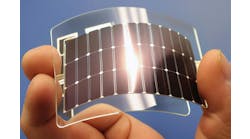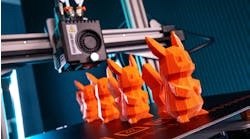The present is mere months away from becoming the future Marty McFly visited in "Back to the Future II." Oct. 21, 2015, to be exact. Just in time for the momentous event no one will care about on Oct. 22, Lexus has released evidence of a working hoverboard.
For as bad as "The Transformers" movies have been, this has restored my faith in the corporations exploitation of '80s nostalgia.
Cynics may point out that the 25-lb bamboo board only works in one custom-made "hoverpark" in Barcelona, which is embedded with magnets. Or that the liquid nitrogen that cools the superconducting blocks to achieve the magnetic levitation effect must be constantly replenished Or that it’s just a very expensive PR stunt and unfortunately not a real available to the public.
Cynicism is understandable in a lot of areas of our society -- especially in the technology sector-- but it has no place here. What the Lexus team, along with scientists at IFW Dresden and and evico GmbH, achieved in 18 months is amazing.
Think about it. Since children first heard the word hoverboard, whispers of its actual existence have delicately floated across playground asphalt the world over. Even last year, skateboarding icon Tony Hawk stirred up the man-child demographic by appearing on the mythical machine, though thatturned out to be a hoax from Funny or Die. Now, modern engineering has made it a reality.
According to Rob Holland of Jalopnik.com, who got to take a test spin, the board works as promised.
“The closest feeling that comes to it is ice skating, but even that’s like comparing the finest silk to 300 grit sandpaper,” he wrote.
The hoverboard isn’t the first outlandish future tech from the movie to make it into our everyday lives. There’s an article from Newsweek.com that goes over all the other technological advances predicted or inspired just by "Back to the Future II," including smart glasses, large screen displays and biometrics.
Popular culture from the ’80s, specifically 1985, hit on a surprising number of predictions about the present day. Here are four more:
Drone technology, "Ender’s Game"
Ender’s Game author Orson Scott Card had the foresight to think up several technologies that operated like the Internet and iPads. The story's major twist revolves around the use of drone technology in a war against alien bugs, although this may be something he was warning us about.
Now, remote operators routinely use Predator drones to perform military strikes. Though out of harm’s way, like in "Ender’s Game," intelligence analysts still feel the psychological effects long after.
“I may not have been on the ground in Afghanistan, but I watched parts of the conflict in great detail on a screen for days on end. I know the feeling you experience when you see someone die. Horrifying barely covers it,” former DGS-1 analyst Heather Linebaugh wrote in The Guardian.
Biogas Plants, "Mad Max: Beyond Thunderdome"
Gasoline was in short supply in this post-apocalyptic future, estimated to be between 2014-2018. The Road Warrior found himself stuck in the city of Barter, which generated its power from methane, the byproduct of the anaerobic digestion of pig waste. The series was also recycled in this year’s "Mad Max: Fury Road."
For years, several factories across the world now employ biogas plants in their sustainability efforts.Germany even has an incentive program to increase biogas to phase out nuclear power by 2022.
Holograms, "Jem and the Holograms"
With the help of a hologram-generating computer, mild mannered Jerrica Benton transforms into Jem, who fronts a band and fights other singers, sort of like Taylor Swift.
In one of the larger scale uses of holograms, GE employs the light constructs to simulate future wind farms to allow engineers to tweak and optimize the height and placement of the wind turbines, as well as blade shape. This practice has reportedly made the capturing wind power 20% more effective.
Awkward Android, "Small Wonder"
Thankfully, the one on this list that hasn’t been made into a movie. In this show that somehow lasted four years, a robotics engineer brings home his pint-sized creation to adapt to humans. In typical '80s sitcom fashion, hilarity does not ensue.
The creators of Atlas, the DARPA-funded robot made by Boston Dynamics, may be a bit more clumsy, but infinitely more entertaining. Atlas is also 6'2, 345 lb, so laughing isn't recommended in its general vicinity.

